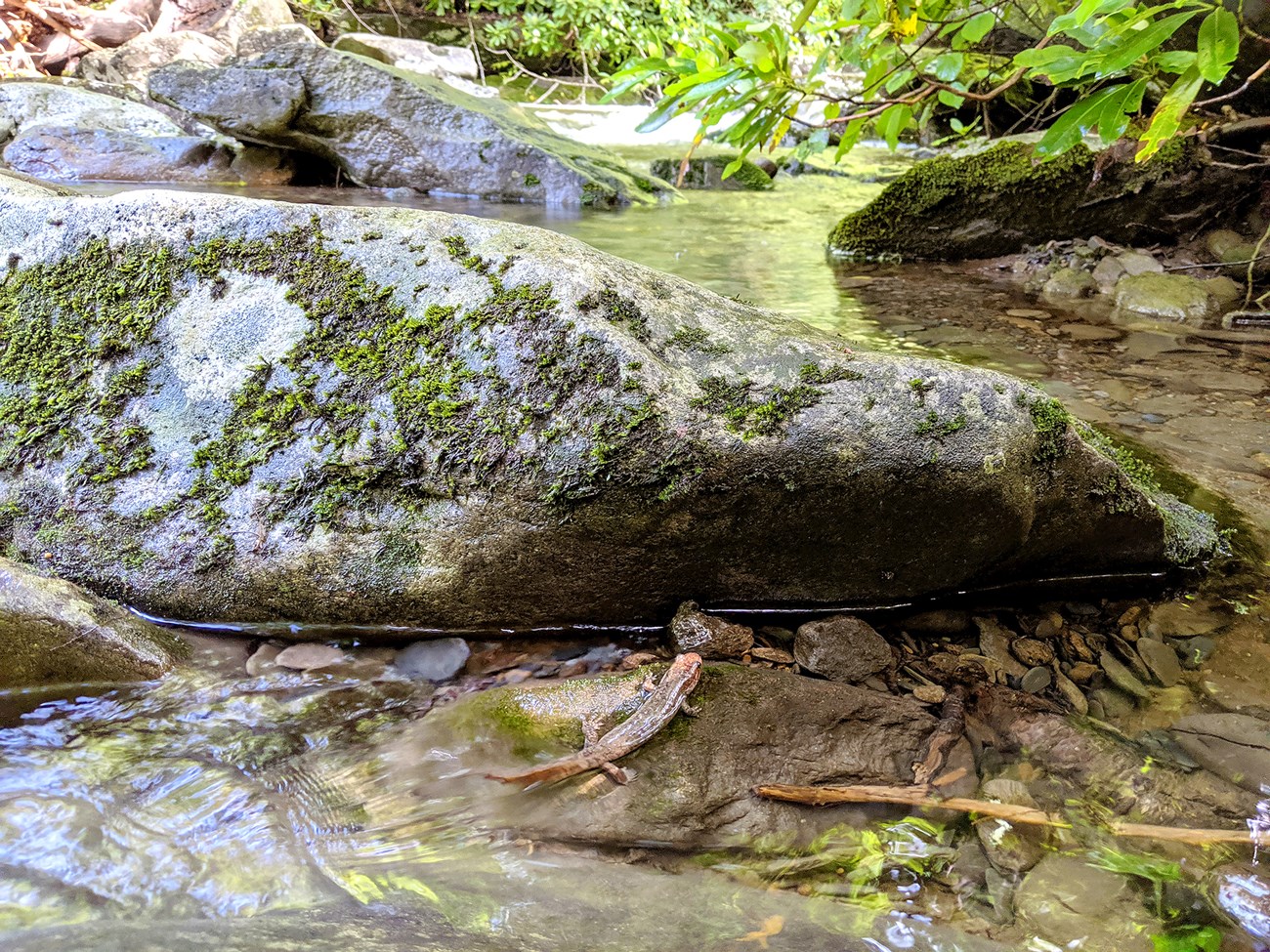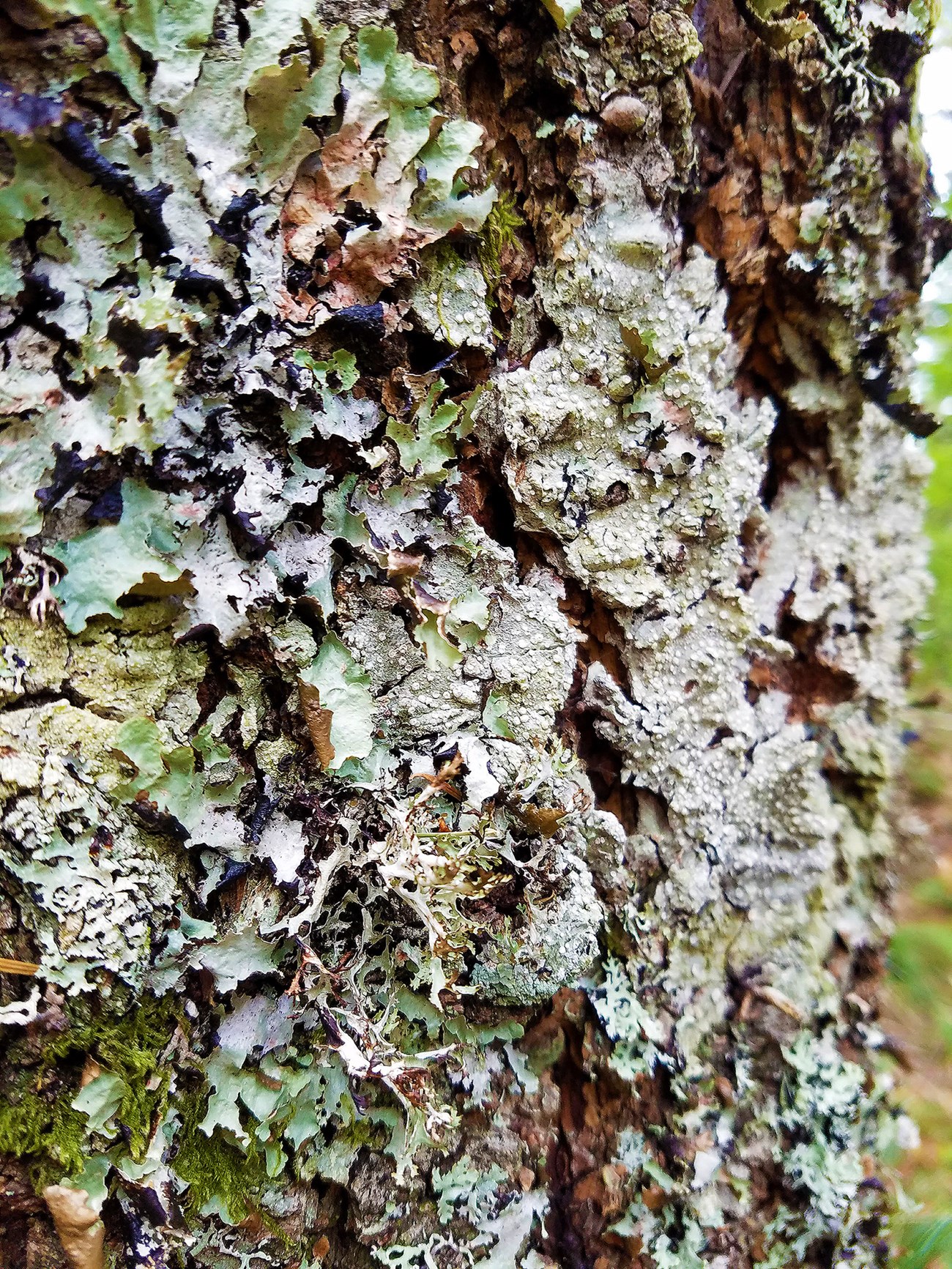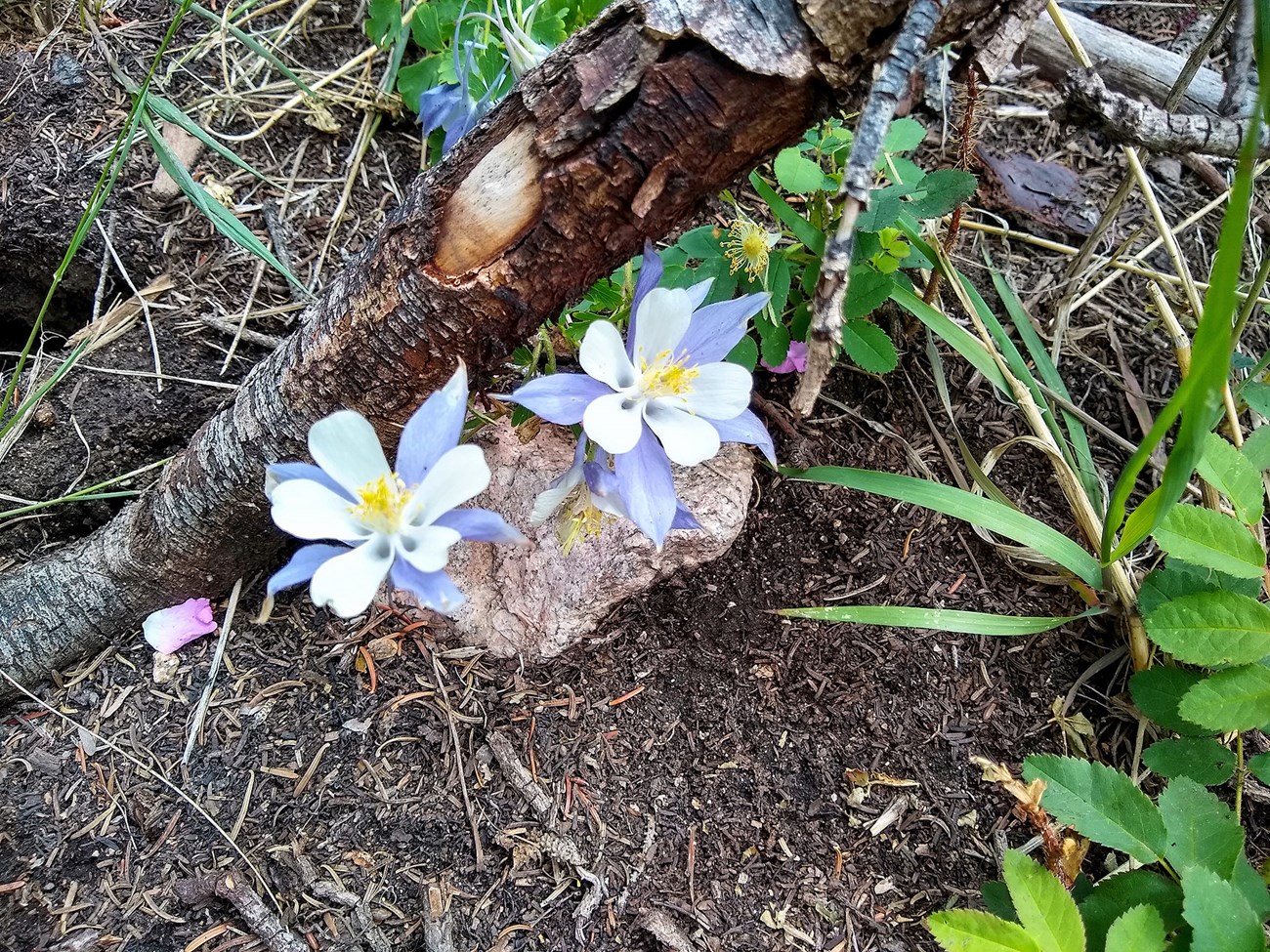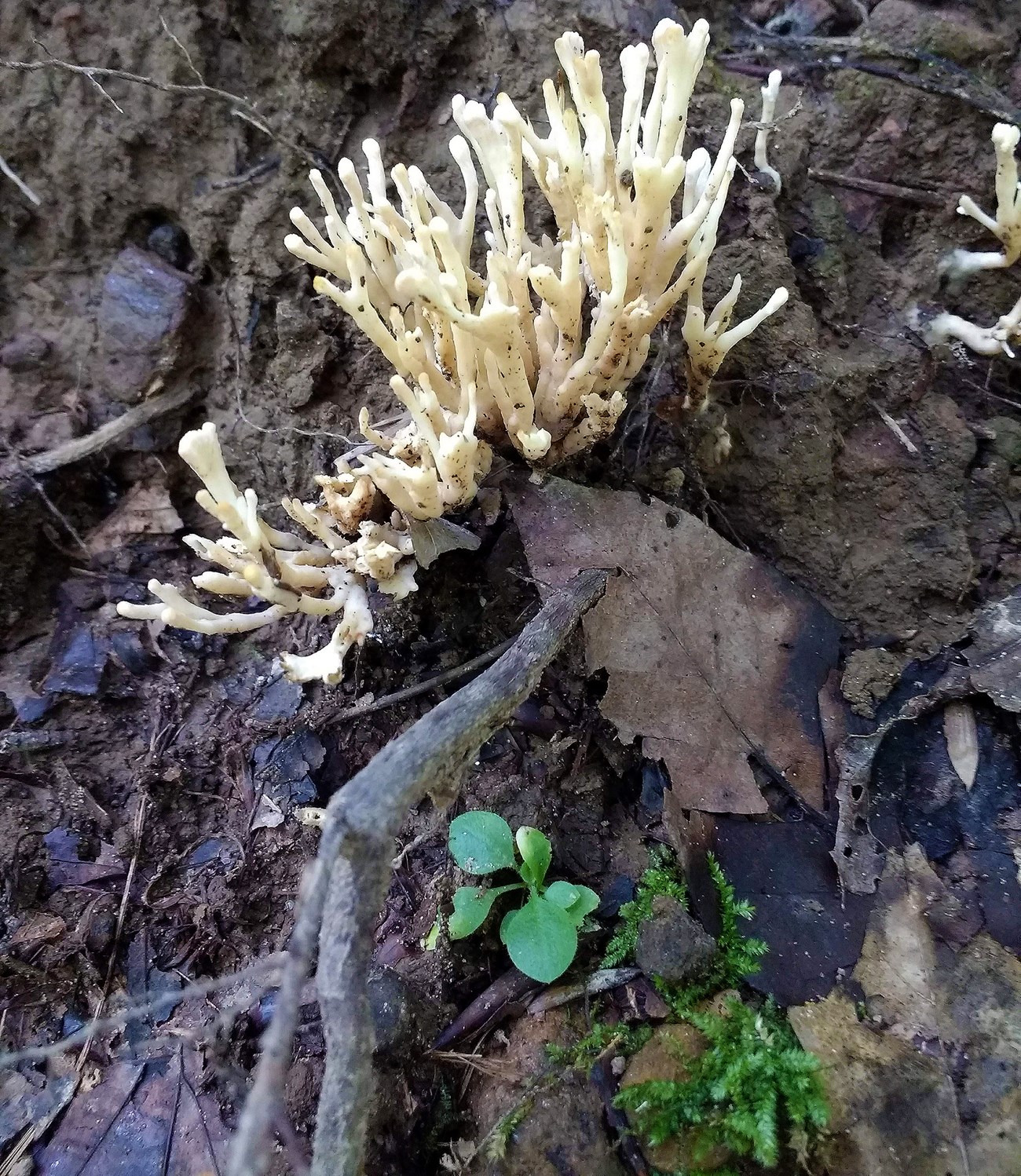Last updated: April 16, 2025
Article
How to Assess Air Pollution's Impacts on Forests
The interconnectedness of living things is evident in a forest, where lichens act as pollution alarm clocks, and soil fungi help trees survive. Scientists studied just four types of organisms in the national park forest ecosystem to gauge its health.
By Mike Bell, Emmi Felker-Quinn, and Ksienya Taylor

Image credit: NPS / C. Keith
The pleasures of walking through a deep forest are many. The rich, earthy smells of mosses. The musical calls of birds. These experiences can impart such a feeling of serenity that it’s easy to believe everything is in a perfectly preserved natural state.
But even though forests may be protected from development, they can still be harmed by pollution from far away. Scientists from the National Park Service’s Air Resources Division noticed that forest streams were losing fish and invasive plants were growing faster, and they wanted to know to what extent air pollution was to blame. Forests are complex ecosystems, so to simplify the task, they studied how key forest organisms—ones that could indicate the overall health of a forest—responded to air pollution. They collected data across hundreds of national parks and scores of species, with mixed results and some intriguing possibilities.
Sulfur and Nitrogen Overkill
Sulfur and nitrogen emissions from power plants, agriculture, and vehicles miles away from a forest can alter its health. The most well-known form of sulfur and nitrogen pollution is acid rain, which occurs when very high levels of these pollutants are in the air. But much lower levels of pollutants can also harm trees and other plants. And sulfur pollution makes soils and waters more acidic, threatening the survival of the organisms that depend on them.
Many eastern national park streams were so polluted they killed off aquatic insects and fish, and the trees in the surrounding forest started to die.

Image credit: NPS / Emmi Felker-Quinn
During peak acid deposition in the 1970s and 1980s, many eastern national park streams were so polluted they killed off aquatic insects and fish, and the trees in the surrounding forest started to die. Sulfur falling on forest soil removed nutrients like calcium, which is important for animals to grow structures like bones and shells. This caused insects on the forest floor to disappear, along with the birds that ate them.
Every part of a forest ecosystem is important to the other parts; they are all interconnected. So those losses reduced the health of the forests, reduced the numbers and kinds of organisms living there, and made visiting them less enjoyable. Thanks to the Clean Air Act of 1970, sulfur pollutants have steadily declined, and many species are starting to recover.

Image credit: NPS / Mike Bell
Although nitrogen pollutants can acidify ecosystems, that’s not their worst impact. Excess nitrogen causes eutrophication, which is when too many nutrients in an ecosystem leads to an overgrowth of harmful organisms. Eutrophication causes invasive plants to spread and algae to bloom in lakes and streams, choking out other forms of life. It can change the structure of a forest ecosystem, reducing biodiversity, increasing fire risk, and making lakes uninhabitable.

Image credit: NPS / Mike Bell
Nitrogen pollution peaked in the 1990s in most areas of the United States. That was before the Clean Air Act amendments of 1990 increased regulation of oxidized nitrogen from power plants and vehicle emissions. Today, nitrogen from crop fertilization and animal farms is increasing, and this is counteracting some of those air quality improvements.
To understand the current risk to forests from these pollutants, scientists study four types of organisms: lichens, trees, non-woody plants, and soil fungi.
Scientists who study air quality call the level of deposition at which harm occurs the “critical load.” The amount of deposition above a critical load is called “exceedance.” Many plant species benefit from small additions of nitrogen, and many soils are able to neutralize a single acid rain event. But human-caused pollution since the Industrial Revolution has elevated nitrogen and sulfur deposits beyond the capacity of most parks to absorb them without harm. Different organisms and soils have different tolerances for pollution, so critical loads vary inside and across parks.
To understand the current risk to forests from these pollutants, scientists study four types of organisms: lichens, trees, non-woody plants, and soil fungi. These are all vital to our nation’s forests, and they provide valuable ecosystem services, nature's benefits to people. Measuring critical loads and exceedances for nitrogen and sulfur pollution in these organisms is helpful for understanding the risk to forests from air pollution.
Bellwethers of Widespread Impacts
Lichens That Live on Air
Lichens are those colorful, plant-like patches or growths you see on trees, walls, and rocks. They are a symbiotic combination of algae and fungi. Epiphytic macrolichen—large, prominent lichens that grow on tree trunks and branches—never touch the ground. They get all their nutrients directly from the air.

Image credit: NPS / Mike Bell
Animals eat these lichens and use them for cover or for building nests. So their loss has cascading impacts throughout the forest.
This dependence makes these lichens extremely sensitive to changes in air quality, serving as the “canary in the coal mine,” an indicator of how healthy the forest is. Increases in air pollutants can poison and kill sensitive lichens. Animals eat these lichens and use them for cover or, like hummingbirds, for building nests. So their loss has cascading impacts throughout the forest.
Tender(ish) Trees
The trees on which lichens grow are also sensitive to air pollution. In one scientific study of over one million U.S. trees of 71 different species, nitrogen or sulfur deposition significantly affected most of them, decreasing their growth and chance of survival. Declines in growth and survival cause a forest to have fewer and smaller trees.

Image credit: NPS / Mike Bell
Nitrogen and sulfur deposition can also lead to increased tree growth, which can actually harm trees. This is because with more nutrients available, the tree puts less resources into root growth and can be more easily damaged by drought, high winds, and pests. The U.S. Forest Service published a 2021 report describing individual tree responses to pollution and the importance of each species to people, plant communities, and wildlife. It’s a great guide if you want to know how the impacts of air pollution on a single tree species can affect the entire forest.
Diverse Wildflowers and Grasses
Air pollution is changing the plants on the forest floor, the understory. These herbaceous—non-woody—species include grasses and wildflowers. They play an important role in plant biodiversity, even in ecosystems dominated by tree species.

Image credit: NPS / Emmi Felker-Quinn
Some of the herbaceous plants are annuals, growing from seed every year, and they’re more vulnerable to change from excess nitrogen and sulfur. In some cases, non-native plants will thrive to the detriment of native ones. Once less-desirable plant species have grown and produced seeds for many years, it’s harder for an ecosystem to return to its original state, even when there’s no more pollution. Changes in herbaceous species composition harm pollinators and animals that eat plants, increasing understory growth and fire risk.
The fungi help extend the plant’s root system, providing their plant partners with more nutrients and water.
Plant Partner Fungi
Many of the trees and understory plants in forests have symbiotic relationships with beneficial soil fungi called mycorrhizae. The mycorrhizae feed on the sugars a plant creates through photosynthesis. In exchange, the fungi help extend the plant’s root system, providing their plant partners with more nutrients and water. Certain trees have formed relationships with specific fungal species.

Image credit: NPS / Emmi Felker-Quinn
But if nitrogen deposition causes excess nitrogen in soils, plants can rely on their own roots to acquire nutrients and stop feeding their fungal partners. That’s fine in good times, but not when the tree deals with stresses like drought and herbivores—animals that eat them. When the tree needs those fungal partners, they won’t be there to help.
Combining the Data into a Powerful, Park-Specific Tool…
Air Resources Division scientists compiled data on each of those four forest ecosystem components (lichens, trees, non-woody plants, and soil fungi) across hundreds of parks for each year from 2000 to 2021. They used national land cover data, deposition data, and models to determine nitrogen and sulfur pollution effects on lichens and soil fungi. And they used the agency’s own vegetation maps to evaluate impacts on herbaceous plants and trees.
For each ecosystem component, researchers calculated critical loads and exceedances. They added their assessments to an online Air Quality Conditions and Trends data visualization tool, which shows park-specific data for the top pollutants. Comparing impacts across parks and years with this tool can show what’s happened to parks over time and help predict future changes.
Park resources aren’t “out of the woods” just yet. In 2021, air pollution threatened lichen, soil fungi, and non-woody plants in hundreds of parks, and trees in scores of them.
The Air Resources Division’s study found that not all parks in the Air Quality Conditions and Trends database have information about the four forest components. More parks have data on lichen than any of the other indicators, followed by soil fungi, trees, and herbaceous plants.
The data show that deposition is mostly declining across the U.S. Out of more than 300 National Park Service units in the contiguous U.S. with trend data, the vast majority are showing declines in sulfur and nitrogen deposition over the last 20 plus years. But park resources aren’t “out of the woods” just yet. In 2021, air pollution threatened lichen, soil fungi, and non-woody plants in hundreds of parks, and trees in scores of them.

Image credit: NPS / Mike Bell
A bar chart with the title “Forests Experiencing Harm from Air Pollution.” The y axis is labeled “Count of Parks,” and the x axis is labeled with four categories: Lichen, Soil Fungi, Herbaceous Plants, and Trees. The legend has two items: “Parks with Data” and “Parks Experiencing Harm.”
The chart shows more than 250 (but fewer than 300) parks have data on lichen, while more than 200 (but fewer than 250) parks have lichen experiencing harm. More than 250 (but fewer than 300) parks have data on soil fungi, while more than 150 (but fewer than 200) parks have soil fungi experiencing harm. More than 200 (but fewer than 250) parks have data on herbaceous plants, while more than 100 (but fewer than 150) have such plants that are experiencing harm. Finally, more than 200 (but fewer than 250) parks have data on trees, while more than 50 (but fewer than 100) parks have trees experiencing harm.
Jim Renfro is an air resource specialist with Great Smoky Mountains National Park. “[The park] was once one of the most polluted national parks in the U.S., mostly being impacted by pollution from coal-fired power plants in the region,” he said. “We used local monitors and provisions within the Clean Air Act to work with local agencies and stakeholders to help get controls placed on pollution sources to reduce emissions affecting the park.”
Sulfur emissions have dropped 80 percent and nitrogen emissions have dropped 50 percent since 1990. But understanding which parts of the park are still stressed will help managers know where remediation is most urgent. “Long-term, continuous, air-monitoring data tied to…projected critical loads of sulfur and nitrogen…was essential,” Renfro and colleague Matt Kulp said, for restoring and protecting sensitive park ecosystems.

Image credit: NPS / Mike Bell
...Has a National Impact
National datasets like the Air Quality Conditions and Trends tool also give us the ability to compare the condition of resources across a region and across agency boundaries. The Greater Yellowstone Area incorporates Yellowstone and Grand Teton National Parks, five national forests, three Fish and Wildlife Service refuges, and Bureau of Land Management land.
“Standardizing the data across agencies results in better collaboration, more confident management decisions, and higher quality outcomes.”
That’s “twenty-two million acres and a diversity of ecosystems,” explained Jill McMurray, U.S. Forest Service air quality specialist and co-chair of the Greater Yellowstone Coordinating Committee Clean Air Partnership. “Standardizing the data across agencies, as the Air Conditions and Trends framework does,” she said, “results in better collaboration, more confident management decisions, and higher quality outcomes [and helps prepare] us for future conditions.”

Image credit: NPS / Mike Bell
Can Reducing Air Pollution Offset Global Warming?
One exciting new direction for this research is showcased in a 2021 study linking changes caused by excess nitrogen and sulfur deposition to those caused by climate change. The same epiphytic lichen species that are sensitive to increased air pollution are also harmed by increased ambient temperatures. The study results suggest that if the U.S. reduces excess nitrogen deposition by about two pounds per acre each year for the next century, it could offset the loss of species richness predicted by global warming. This could be an opportunity to mitigate the harmful effects of climate change by reducing pollutants like nitrogen and sulfur.
If the U.S. reduces excess nitrogen deposition by about two pounds per acre each year for the next century, it could offset the loss of species richness predicted by global warming.
Knowing where nitrogen and sulfur pollution levels exceed critical loads and which species are at risk has obvious benefits. “Air touches everything,” said Air Resources Division planner Jim Cheatham, “so identifying which species and ecosystems are at risk builds connections with other stressors such as fire, invasive species, and the threat multiplier of climate change. Using trends to forecast change also helps prioritize where management action is needed.”
But future updates to the trends tool will need additional information from parks. While making these updates, scientists plan to work with parks and Indigenous Tribes to identify lichens, herbaceous plants, trees, and fungi that are culturally relevant. That information would enrich and extend these data’s implications and usefulness in ways we can only imagine.
About the authors

Mike Bell is an ecologist with the National Park Service’s Natural Resource Stewardship and Science Directorate. Image courtesy of Mike Bell.

Emmi Felker-Quinn is an ecologist with the National Park Service’s Natural Resource Stewardship and Science Directorate. Image courtesy of Emmi Felker-Quinn.

Ksienya Taylor is a data scientist with the National Park Service’s Natural Resource Stewardship and Science Directorate. Image courtesy of Ksienya Taylor.
